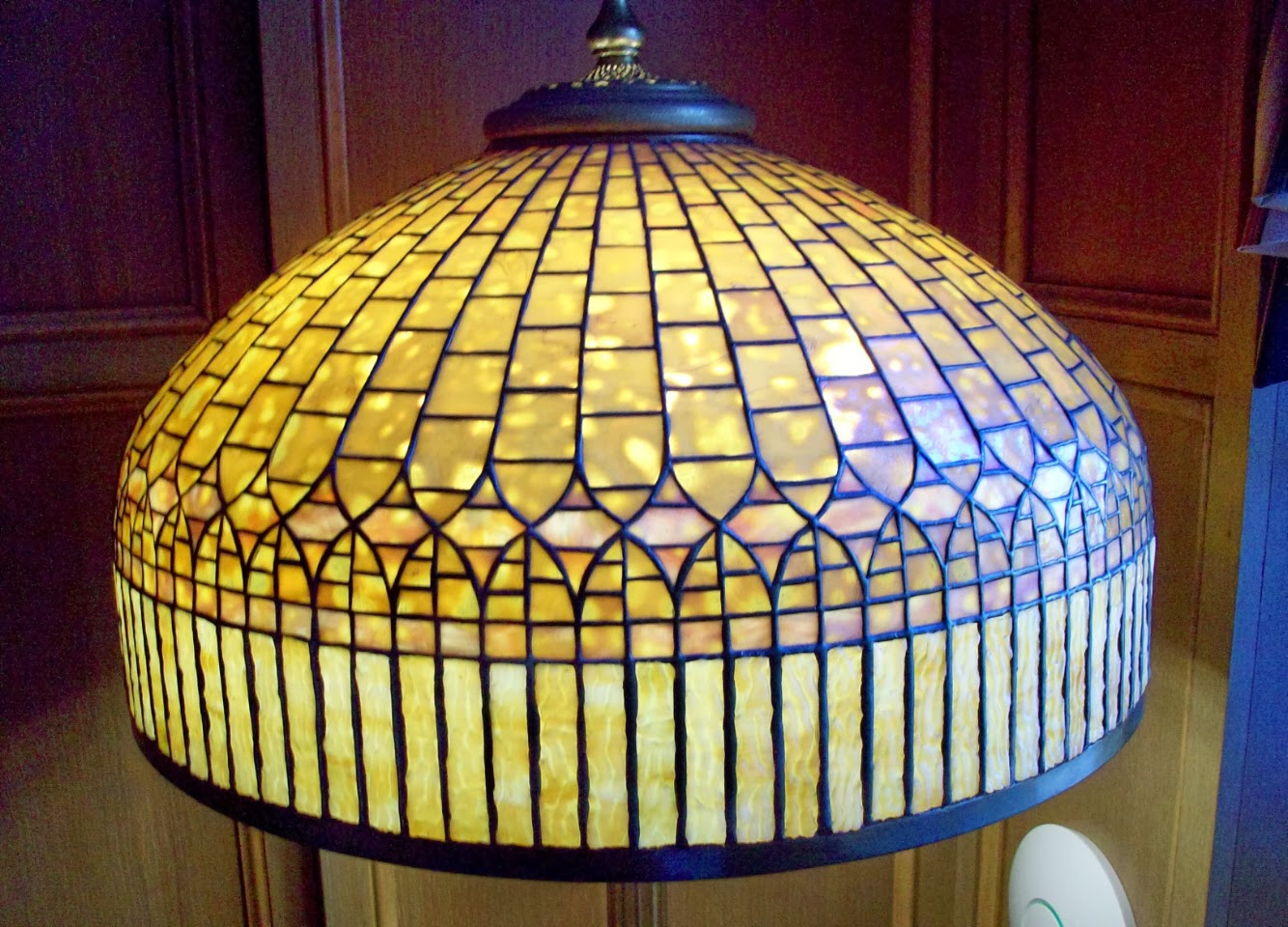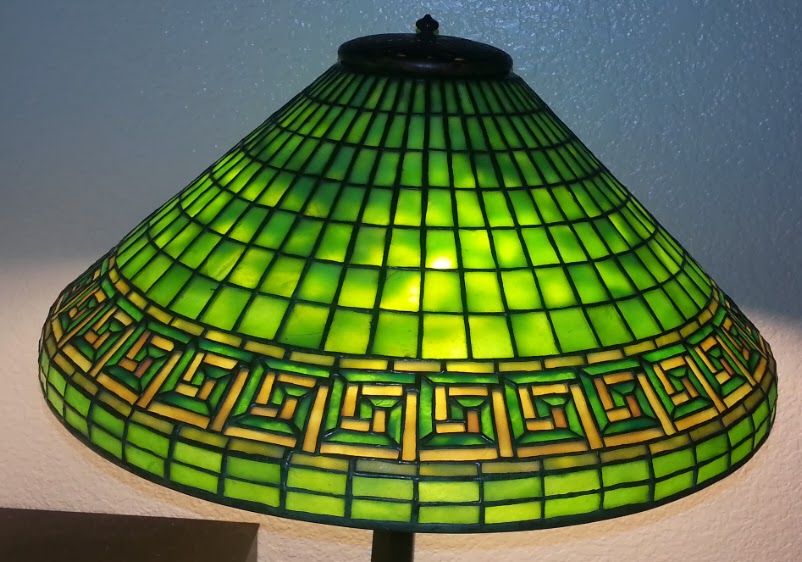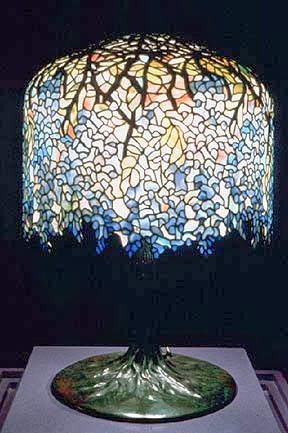Since 1970 I have collected antiques and fine art. I became interested in antiques and fine art during college and with mentoring from 3-4 very experienced collectors I got a hands on education about everything from 17th -19th century furniture, to art glass, antiquities, American and European decorative accessories and other lovely treasures. I was most interested in the 18th-19th century items at first; then my focus shifted a bit. I became fascinated with American art glass, and in particular, Tiffany Studios art glass and Tiffany Studios lamps. Tiffany Studios items had started to become collectible and valuable, whereas in the years before about 1962, collectors of lovely antiques and art bought Tiffany Studios lamps and glass for their homes from the few dealers who sold them, but their value as a "collectible" had not reached very high levels with rare exceptions.
Over time, when people have asked me if buying a certain antique or in this case, a Tiffany Studios lamp would be a "good investment," I have always been cautious in my reply. My usual response to anyone buying any kind of antique or fine art piece is to "buy what you like and what is within your budget." It has been well established over the past hundred or more years that certain categories or specific artists or types of antiques and fine art have "held their own" and been somewhat the "blue chips" of the antiques and art market. As far as retaining and gaining in value, the art and antique market, and in this case, the market for authentic Tiffany Studios lamps, has always been somewhat subject to trends in decorating, and it certainly is affected by economic booms and downturns as are other antiques and collectibles.
The recent severe recession had a devastating effect on many auction house and private sales results. Many dealers in antiques and fine art had to either close up shop or sell things at liquidation prices to stay afloat. The number of people investing their money into what most people would consider luxury items, diminished substantially. Millionaire collectors quit buying art and antiques. From my personal knowledge, collectors of Tiffany Studios lamps, because they were facing either tough times, having made their fortunes for example in real estate, or simply because times were so uncertain, stopped buying Tiffany Studios lamps. The wisest collectors within this usually "financially secure" collectors group were either not buying at all or they were buying only if they could get something at a "bargain basement" price.
During the recent recessionary time period, auctions at the major houses in New York which normally would see from 100-200 or more people seated for an important sale, were seeing a large number of empty seats. There were great bargains to be found, and likewise, many items simply went unsold. The prices for the vast majority of things (the exceptions were the very rarest and fine examples of art or other antiques), were as depressed as the auction house experts and the antique and fine art gallery owners. The prices for authentic Tiffany lamps "tanked," with everything else, and with rare exceptions was not immune at all to the economic free fall.
Getting back to the question, "Are authentic Tiffany lamps a good investment?," my advice to Tiffany Studios lamp collectors, or to people who might have inherited a Tiffany Studios lamp is this: There are no guarantees that any kind of personal property, new or antique, will be a good investment over time - whether it is a five year or twenty five year time frame. Just as the fashion industry, auto industry and housing market have all changed over time as to what is "in" and "popular" and what is "out" and less in vogue, the same thing can and does happen with antiques and fine art. And as it does, prices naturally rise and fall. If you love authentic Tiffany lamps and have the money to buy one, I suggest to everyone that they buy the best quality lamp they can afford; a lamp with the most desirable colors and the most popular pattern over time (such as the poppy, dogwood, peony, daffodil, apple blossom, tulip, or dragonfly patterns). Buy a lamp that, in your knowledgeable opinion, or in the opinion of someone who is a Tiffany lamp expert, has very nice glass properties, great colors and is in excellent condition. If it has a base, make sure it also has an "appropriate" and high quality base. The best chance a collector has for their authentic Tiffany lamp to hold its value and to appreciate in value over any time frame, is to buy the style and patterns which have, over the past 40-50 years, consistently been popular, or to buy one of the very rare styles of Tiffany lamps, which historically have brought the best prices at public and private sales.
Below are two examples of very high quality lamps which are expensive lamps to buy now, and which will be much more likely to hold their value and be a "good investment" over the years to come. Again, nothing is guaranteed, but even in slow economic times, an item that was once $1000.00 in value is still going to be worth more than a similar item that was once worth only $250.00. Above all, buy what you like. Do not buy with the intention of making a killing in five years by re-selling your lamp for a huge profit, unless you are lucky enough to find a $100,000 lamp at an estate sale or small town auction for $5000. That happens very rarely these days.
Above, is a good example of a Tiffany Studios lamp which is both rare in pattern, and which also has lovely colors and a desirable base. Definitely "investment quality."
One could not go wrong if they had the money to invest in a nice "Wisteria" pattern Tiffany Studios lamp like the one pictured above. As long as you do not overpay, you should be fine over time. They were one of the most expensive lamps made in the early 20th century by Tiffany Studios, and they remain one of the most sought after and valuable lamps which sell at auctions and privately today.
Whatever you decide to do, always be sure to either know yourself how to determine absolute authenticity of a Tiffany Studios lamp and its fair value, or hire someone to help you in determining those things. There are extremely good forgeries around these days, using old glass, old parts and old stamps for the signatures.
If you are lucky enough to have inherited a nice Tiffany Studios lamp, it is your decision whether to hold onto it or sell it and use that money for something that you perhaps like better or can better use in your lifestyle. There is always the chance of accidental damage to any lamp. Once this happens, it can either ruin the value of a lamp entirely, or it can cost many thousands of dollars to restore the lamp properly. I work with many people who have inherited or purchased lamps, and who decide to sell them because they fear their children or grandchildren will knock them over or otherwise damage them beyond repair. Some unfortunate Tiffany lamp owners have also knocked their lamp over themselves, which is possibly the most distressing scenario of all!
If you are lucky enough to have inherited a nice Tiffany Studios lamp, it is your decision whether to hold onto it or sell it and use that money for something that you perhaps like better or can better use in your lifestyle. There is always the chance of accidental damage to any lamp. Once this happens, it can either ruin the value of a lamp entirely, or it can cost many thousands of dollars to restore the lamp properly. I work with many people who have inherited or purchased lamps, and who decide to sell them because they fear their children or grandchildren will knock them over or otherwise damage them beyond repair. Some unfortunate Tiffany lamp owners have also knocked their lamp over themselves, which is possibly the most distressing scenario of all!
More to come...
Dennis
Email Me
Visit My Website
Google+
Phone: Toll Free (888) 663-0606 10 am - 10 pm EST Daily










